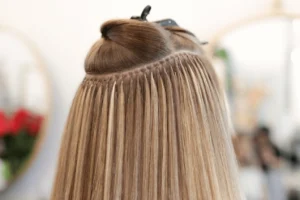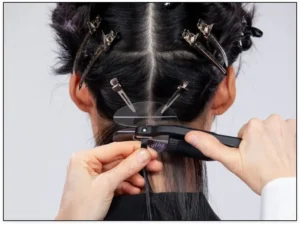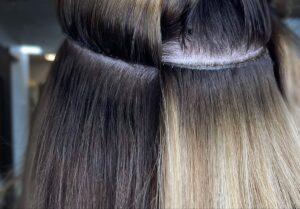Unlocking the Secrets of Hair Extension Processing: A Comprehensive Guide
Hair extensions are attached using various methods, broadly categorized into strand-by-strand and wefted panel techniques. Strand-by-strand methods include bonding1 (using keratin or adhesives), micro links (using small beads), and fusion2 (melting a keratin bond). Wefted panel methods involve tape-in extensions3 (using adhesive strips4), clip-in extensions (using clips), sewn-in extensions5 (using a needle and thread), and glued-in extensions (using a special adhesive). Each method offers different application times6, durability, and maintenance requirements7. As someone deeply entrenched in the hair extension industry through Plucharm Hair, I understand the complexities and beauty involved in attaching these transformative accessories to enhance one’s look. Let’s delve into the fascinating world of hair extensions8 and explore what makes them tick.
What is the Most Popular Hair Extension Method?
In the vibrant tapestry of hair extensions8, determining the most popular method can seem like searching for a needle in a haystack. However, the demand consistently leans toward methods that seamlessly integrate with natural hair while maintaining a luxurious look.
Dive Deeper
Among hair aficionados and salon experts, tape-in extensions3 reign supreme. Why? Their ability to offer a natural appearance, ease of application, and relative affordability make them a go-to choice. Imagine walking into a salon for a drastic transformation and walking out after a mere hour with hair that blends so perfectly, no one could tell it apart from your real locks. Personally, at Plucharm Hair, we've seen a significant uptick in demand for our tape-in extensions3. They're a hit for those seeking both volume and length without the commotion of a lengthy appointment. They boast a maintenance sweet spot—firm enough to endure daily wear, yet gentle enough to maintain hair integrity.
Expert Insight: Pro Tip: “Tape-ins are suitable for nearly every hair type9. With the right installation and care, they can last up to 8 weeks, making them a practical, cost-effective choice.”
What is the Process of Hair Extensions?
Understanding the processing of hair extensions8 is crucial for anyone looking to delve deeper into their benefits and application methods. From the moment a hair extension is crafted to the final application, the journey is both intricate and fascinating.
Dive Deeper
The creation of hair extensions8 begins with sourcing. High-quality extensions, like those we pride ourselves on at Plucharm Hair, use virgin hair10, untouched by chemical treatments. This ensures maximum longevity and natural shine. From here, the hair undergoes several steps: cleaning, coloring, and crafting into either strand-by-strand or weft panels.
- Bonding is a meticulous process involving bonding1 agents like keratin, integral in securing the hair strands strand-by-strand.
- Micro links require skilled hands to strategically place small beads along the strands, which are then clamped onto the natural hair.
- Fusion methods are time-intensive but immensely durable, where the keratin bonds are melted onto your natural hair.
Each method reflects not only a different technique but also a distinct experience for the wearer in terms of comfort, aesthetic, and upkeep.
Did you know? Fusion extensions have been around since ancient Egypt, proving the tenacity and timeless allure of hair transformation11.
What are the 4 Methods for Attaching Hair Extensions?
Simplicity meets sophistication in the art of attaching hair extensions8. Four standout techniques captivate the market due to their versatile applications and distinct advantages.
- Bonding: Quick and effective, bonding1 uses keratin or adhesives to attach the extensions.
- Micro links: Tiny beads that attach extensions to small sections of natural hair.
- Tape-in extensions: With adhesive strips4, these panels blend effortlessly for a natural look.
- Sewn-in extensions: For a more secure, long-term solution, these are attached using needle and thread.
Dive Deeper
A comparison reveals their unique offerings:
| Method | Application Time | Durability | Maintenance |
|---|---|---|---|
| Bonding | 1.5-2 hours | 6-8 weeks | Moderate |
| Micro Links | 2-3 hours | 10-12 weeks | High |
| Tape-in | 45 minutes-1 hr | 6-8 weeks | Moderate |
| Sewn-in | 2-4 hours | 6-8 weeks | Low |
At Plucharm Hair, the variety in our extensions ensures that salon owners find the perfect match for their clientele's needs. Those seeking a balance between durability and low maintenance often prefer sewn-ins, whereas others desiring a quick application might opt for tape-ins. My advice as a seasoned professional? Match the method to the wearer’s lifestyle and hair type9 for optimum results.
What is the New Method of Hair Extensions?
In an ever-evolving industry, staying ahead of trends means embracing innovation. Recently, the hair extension landscape has welcomed innovative techniques that push the boundaries of comfort and believability.
Dive Deeper
The Invisible Bead Extensions (IBE)12 represent a game-changer. This method eliminates exposed beads or bands, creating an undetectable ensemble that feels smooth and sits harmoniously with natural hair flow. It’s the latest evolution in the pursuit of invisibility.
- Installation: Involves beading and sewing the wefts in a way that ensures they lay flat and hidden.
- Longevity: These extensions can last up to 10 weeks, making them a long-term solution for many.
Before/After Scenario: Imagine transitioning from bulky, often visible extensions to a seamlessly invisible result where others merely admire your length and lustrous hair without suspicion of enhancement.
Pro Tip: Regular maintenance every 6-8 weeks will ensure these extensions remain as discrete as the day they were applied.
Conclusion
Navigating the diverse methods of hair extension application is like mastering an art form—it requires knowledge, skill, and the right products. At Plucharm Hair, we’re dedicated to delivering only the finest extensions that prioritize both beauty and integrity. For salon owners, understanding these methods not only boosts your competitive edge but also ensures your clients walk away with confidence and satisfaction.
Remember, the right method and quality can transform a head of hair, offering more than just length or volume—it offers empowerment. Let Plucharm Hair be your trusted partner in delivering unparalleled hair experiences.
For those ready to explore or expand their hair extension offerings, visit Plucharm Hair and let’s elevate the hair industry together.
-
Learn about the bonding method and its effectiveness in securing hair extensions. ↩ ↩ ↩
-
Understand the fusion method and its durability for long-lasting hair extensions. ↩
-
Discover why tape-in extensions are favored for their natural look and ease of application. ↩ ↩ ↩
-
Explore how adhesive strips provide a natural look and easy application for tape-ins. ↩ ↩
-
Explore the benefits of sewn-in extensions for a secure and long-term solution. ↩
-
Find out how long each hair extension method takes for application. ↩
-
Learn about the maintenance needed to keep your hair extensions looking great. ↩
-
Explore the transformative benefits of hair extensions and how they can enhance your look. ↩ ↩ ↩ ↩ ↩
-
Get tips on selecting the right hair extensions that match your hair type. ↩ ↩
-
Understand the significance of virgin hair in ensuring quality and longevity. ↩
-
Discover the empowering effects of hair extensions on your overall appearance. ↩
-
Discover the innovative Invisible Bead Extensions and their seamless application. ↩





